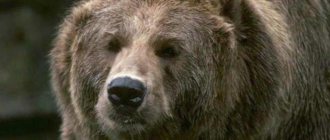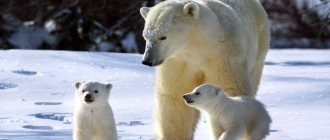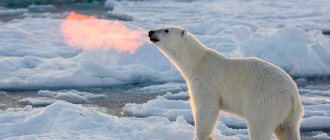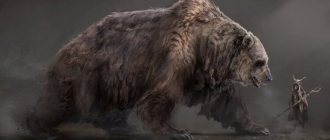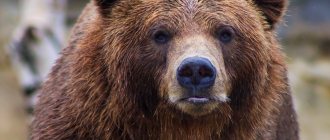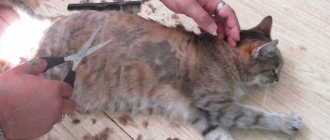Jami Tarris/Getty Images
Armed with amazingly powerful front legs, the brown bear, also known as the grizzly, is the fastest of the eight bear species, reaching speeds of up to 56 km/h (56 km/h), according to the National Wildlife Federation.
The grizzly bear is only slightly faster than the world's most common bear species, the American black bear.
Of course, a bear would only be able to achieve such a feat at the peak of its athleticism - not fresh out of hibernation, having lost 15% to 30% of its body weight - and only on certain soft, flat surfaces that its long claws can dig into ().
Either way, bears are surprisingly fast given their enormous build. Discover the traits and characteristics that make their speed possible, and what to do (other than run) if you encounter one in the wild.
Their Speed and Why You Can't Avoid Them
The maximum speed the bear knew from his watch was 40 miles per hour. This is out of the blue, and because of this, the spreading myth cannot go down. You should know that I couldn't be further from the truth, so don't try to run away from a bear, even if you do it downhill.
Why?
- People can't run as fast as bears. Usain Bolt is the fastest man today, and can only do 28 miles per hour .
- If you run down faster, so does the bear, so its speed is definitely faster than the current 40 mph
- When you work under a lot of pressure, you don't pay enough attention to the road ahead, and fear can cause you to stumble and fall.
- Research has shown that running faster than a bear can reach is the main reason people die when coming face to face with a bear.
However, different species of bears end up running at different speeds. Some sources indicate 37 mph for a black bear, while others top out at 40 mph, but that's in the same general area. Brown bears are a little slower, reaching speeds of only 30 mph, but they're not worth messing with either.
Origin
The first bears on the planet appeared at least five million years ago. The oldest fossil remains of these animals were found in France. Today, scientists know four genera of this animal, of which the polar bear is considered the youngest in origin. Its total biological age is only two hundred thousand years.
The body length of a bear can reach 2 meters (white-breasted and black bears) and 3 meters (white and brown bears).
Maximum body weight is 750-800 kg. These dimensions, of course, are large, but are not comparable to the dimensions of the giant short-faced bear, which lived in Sulfur America back in the Pleistocene era and has long since become extinct. He, standing on his hind legs, could be almost three times taller than an ordinary person, and the mass of the largest representatives reached one and a half tons!
How long can you keep this up?
If you're wondering how fast bears are, you have to ask yourself how long they can do it. Speed is an important factor when avoiding a bear attack, but so is resistance. Also, what if you have an advantage? Could this help you escape the bear to safety?
See also: How to scare a bear: bare needs
Then we will tell him again: the unfortunate truth is that he cannot escape from the bear. Let's say you are Usain Bolt, reading this article. If you are racing a black bear in a cover that is one mile away, it will take you 2 minutes and 8 seconds. It will only take the bear 1 minute and 37 seconds if its speed is 37 miles per hour.
This means that he will need more than 30 seconds of advantage, during which time the bear can run 0.32 miles. So if you just need to get past the finish line and get to safety, you'll need a 0.321 mile lead. But remember that everything is in perfect condition, without other factors such as:
- Earth . Running on an incline can make you even more tired, faster. Even if you are running downhill, you can trip and injure yourself, which will take you out of the competition.
- weather . If it rains, the likelihood of you slipping will increase exponentially, in addition to destroying your morale far from your sight. If it's windy, air friction will also make you run slower. Needless to say, bears are less affected by weather than humans...
- Your emotions . If you're afraid, you may pay less attention to where you're going and make impulsive decisions, such as taking a dangerous turn to make you fall. Or it could completely motivate you to run faster.
- How decisive is a bear ? If you've spoiled a mother bear who wants to protect her cubs, you've really done it. A female bear will chase you longer than a female bear who is only interested in scaring you.
- You're probably not Usain Bolt. That in itself explains it.
Resistance: you versus the bear
Another factor: bears do have a lot of resistance other than speed. Some research has been done with bears in Yellowstone National Park and it has been found that brown bears can maintain speeds of 25 to 28 mph for at least 2 miles without getting tired.
If they run faster, at 30 mph, they can make it just over 0.25 miles. The most interesting fact is that these findings refer to bears running on asphalt, which is ground for which they are not built. If they are running through the forest, they can be faster.
So here's another factor for you: While humans are slower on the ground due to poorer traction, bears are faster because they use their claws to gain more momentum. What is Usain Bolt's resistance? A couple of seconds, then you kill. Basically, if we're talking about advantage, I need 2 miles, not 0.32.
In real conditions, thanks to a little thing called resistance. Can you see a bear when they are 2 miles away? No, but he can definitely smell you. So the race can go on even if you don't know it's going on. This is why in real life you can't even think about getting a good enough advantage to save your life.
Daily activity of moose
With the arrival of spring, moose continue to lead a diurnal lifestyle, and in the summer heat they become nocturnal animals. Not only the heat, but horseflies and midges drive elk into saving forest reservoirs.
When you get tired of relaxing in shallow water, the animals spend their time usefully: swimming and diving for aquatic vegetation. The speed of the moose during the swim is 2 km/h. And the elk can stay under water for up to 50 seconds.
Sprint races are not typical for moose. He goes into a gallop when he is wounded or frightened. Despite its endurance, a moose cannot run for long, but it is interesting to know who it will defeat in a hypothetical marathon.
How can bears be so fast??
In addition to the question of how fast bears are, several others are equally important.
Doesn't this defy the laws of physics???
It is strange that nature allowed these mammoths this kind of speed and endurance. It’s hardly physically possible to run like that when you’re built like that.
Keep in mind that bears run even faster than nature's most agile creatures. Plus, they make very precise turns, even when running at full speed.
Doesn't your speed contradict the laws of evolution???
Besides being able to run so fast, why would they do that? From an evolutionary perspective, this seems a bit exaggerated, given that bears are omnivorous opportunists rather than agile hunters like cheetahs. Therefore, they could easily adapt to their environment without becoming such good runners.
Shouldn't their physical attributes prevent them from running??
- Its shape is not aerodynamic. generally considering
- They don't have long lines to give them more momentum.
- His coat compensates for air resistance. slow down
- they It does not have moving spines .
- His eyesight is really bad and they can't identify the dam which is further away .
- They will significantly increase your body fat during hibernation , but this does not reduce your speed or agility.
Although we are not scientists, we are thinking of explanations in this regard:
They may have a lot of muscle mass
When it comes to running, strong muscles do the work. Even if it is not aerodynamically shaped, the air friction is not so great as to counteract the momentum generated by a large muscle mass. For example, there are powerful cars that reach even higher speeds than elegant ones thanks to powerful engines.
Basically, his strength is so remarkable that it defies wind resistance and also seems to defy the laws of gravity.
Light weight leads to loss of balance
Heavy weight makes you more stable, especially when making tight turns at high speed. This is because you have to fight the centrifugal force and stay on track.
Additionally, thick and heavy objects have their center of gravity closer to the ground, so they don't lean forward or turn sideways when turning...
Their fat stores give them more energy.
When we talk about a bear's speed and endurance, we are talking about energy. And if bears have all that body fat, they can easily burn it off to keep them on the road longer without getting tired or losing strength.
Their size helps them speed up
Speed requires acceleration, and brown bears can reach speeds of up to 30 mph in less than two seconds. They have a lot of strength, and their heavy weight contributes to this.
Additionally, when it comes to crossing the finish line first, that first burst of acceleration is equally important for average or top speed. Acceleration is affected by the following characteristics:
- What a muscular animal it is.
- How thick is his tendon?
- How much does it cost by weight ?
- What your leg bones are located .
- like long leg bones .
- how flexible is your spine .
So even if bears don't have some of the above characteristics, they do have others that help them accelerate, which explains their high speeds. Besides, they are not the fastest in the animal kingdom, so there is no paradox here.
No muscle mass is lost during hibernation
Even if we sleep for several months at a time, we turn into a flabby mass of mucus, which does not happen to bears. Evolution helped them maintain muscle mass by putting a layer of fat on them.
Essentially, there is no reason for a bear not to be as fast as before waking up from sleep. Yes, he has a few extra pounds, but he's also rested and hungry, so that means more. For more information on hiking 101 and other safety tips, see our article on the topic.
Reproduction
The mating season for grizzly bears begins in mid-May, and the entire process takes no more than a month. While searching for females, the male begins to growl loudly, thereby attracting females to his territory.
There are funny cases when two tall bears sort things out for the right to impregnate them. Each predator has a harem of three or four females. During the mating ritual, he protects them from rivals. But females prefer to mate with two or three males.
After 8 - 9 months, the female brings a litter of 2 - 3 cubs. Babies are born blind and deaf, covered with sparse hair, weighing no more than 500 grams, and their length does not exceed 25 cm.
Only the female participates in the rearing process. After 3 - 4 months, the babies become a size that is comparable to the size of a dog. They develop slowly, only after 3-4 years they become independent and leave their mother. The young body of a grizzly bear grows up to 11 - 13 years.
What is your plan in case of a bear attack???
If you go on a hike to a place where you know there are bears, you will most likely encounter one because it is his territory. So what do you do if this is the case??
In an open field
- Check out the bears around by carefully scrolling across the horizon.
- If you have binoculars with you , that's even better.
In the forest
- Let the bears know you're nearby by making loud noises to scare them away .
- Look around and watch out for trees where you can climb .
- Make sure you can do this quickly because bears can climb trees themselves, up to 30 feet.
If they haven't seen you
- This usually happens when the bear is at least 350 feet away from you .
- Don't let the bear know you're there.
- Walk back slowly and leave plenty of room for the bar to take off.
- It is better to leave completely and follow a new path.
- If you need to stay on your path , make sure you walk as much as possible and stay there until the bear leaves.
- Move in favor of the wind as much as possible so that the bear does not smell you.
If they saw you but you are 350 feet or more from the bear
- Act normally and give the bear a chance to recognize your presence.
- Don't act threatening.
- Start speaking calmly and casually. . Don't scream or shout.
- Walk away slowly , back.
- Keep looking at the bear as you walk away.
- You should definitely look for a different route now, but in favor of the wind so the bear can follow you.
- Don't stop talking, even if you have completely lost track of the bear still knows you are there.
If they saw you and the bear wants to attack
The situation is worse if:
- There's a black bear involved. They can run faster and are also more aggressive than grizzlies.
- There is a mother with puppies. It's worse because she instinctively sees you as a threat even if you aren't.
- There are no trees around. This means that you will have no way to find shelter .
- You don't have much time to climb a tree.
What should you do in this situation:
- Keep calm . Yes, we know it's easier said than done...
- Don't run . If you're wondering how fast bears are, now is not the time to find out. Running will activate your prey drive and they will chase you. Therefore, if a bear wants to attack, running will not stop it.
- Try taking a step back very slowly . Keep the bear in front of you and act calmly, speak quietly and do not startle it. Try to avoid eye contact because it is a sign of challenge and the bear will see you as a threat.
- Don't throw your backpack around waiting for the Bear to show more interest in this, you should use the backpack as a shield if it's time to push.
- Try to climb at least 30 feet through a tree . Even if you can't go that high, you should do so to perceive him as less threatening. Although the bear might come after you, you really hope he doesn't want to.
- If accused, consider it probably a bluff . Bears have been known to do this to scare away a perceived threat. Stay calm and keep coming back.
- Do not use pepper spray unless you are 15 feet or closer to the bear . Otherwise it will have no effect and the bear will see it as a threat. Or it could be even worse if it's windy. See our article on bear pepper at the top to use when an encounter is imminent.
- Direct the spray level with your eyes. before using it if he is less than 15 feet from the bear, calmly (yes, we still know what that sounds like). You do this to at least confuse the bear, if not stop it completely, and buy yourself time.
- In the event of a real black bear attack, you should not play dead . Fight the bear as much as you can because black bears can get spooked easily. Moreover, he has no other choice if he is attacked, especially at night or when a woman is involved. Use everything you have as a shield and cover your head and chest above everything else.
- If you are attacked by a brown bear, it is better to play dead . The reason is that most grizzlies are trying to fight you to protect themselves and you are telling them you are quitting. You can show that it is not threatening by adopting a fetal-like position with your legs covering your chest and head. Another good position is to lie on your stomach to protect your face and chest, with your backpack covering your back and neck...
- It is advisable to see dead as a last resort because you need to keep your eye on the bear to adjust your tactics for as long as possible.
- If you have escaped the attack, now is the time to remain calm. . Don't get up for a few minutes to give the bear enough time to leave. So don't immediately start running and screaming for help, as this can definitely pose a threat to the bear. Although, if you are able to run and scream after a bear attack, more power to you.
Are you walking past your loner? Then check out our advice you should read when walking alone on a path for more information.
Where is it found?
The most widespread and one of the largest predators is the brown, or ordinary, bear. Now its habitat, of course, is much smaller than in the old days. It is also found, in particular, in the Pyrenees, the Alps, in places in the Scandinavian countries, in Asia - in Iran, Northern China, Japan. Still quite abundant in Alaska and Northern Canada. In Russia, the habitat approximately coincides with the forest zone, except for the southern regions and tundra.
Bears (except polar bears, of course) prefer mountainous areas, dense forest thickets and windbreaks as habitats.
What's the conclusion??
Besides the fact that bears are really fast, it is advisable not to mess with them. There are many possible explanations for how they got so fast, even if it seems strange. But even if they are faster than humans, they are definitely not the Usain Bolt of their kind.
Remember that the bear can still catch him whether he is walking up or down the slope and does not try to escape from him. There is no way to gain a realistic advantage. Read our article on basic camping and walking safety guidelines to give you more protection and peace of mind.
However, let us know if we missed anything. Are there other myths or fun facts related to the speed of bears that we haven't mentioned? Have you ever encountered a bear in third grade? Comments below!
Useful evidence about the life of clubfoot
The animal lives on average about 30 years. The predator is not at all afraid of humans and has many similar features.
- The bear is an omnivorous animal. His diet is dominated by two-thirds of plant foods. It prefers to consume insects and fish from water bodies. Sometimes the clubfoot may begin to hunt deer or roe deer.
- Just like humans, bears rest on the entire area of their feet. They are able to stand on two hind legs and move around in this position.
- The animal's eye perceives this world in color.
- Their minds are capable of projecting primitive logic. Bears have excellent memory and great intelligence.
- Humans and predators have many common pathologies.
- The animal easily fights off attacks from angry bees due to its thick fur. In nature it is impossible to find enemies for the clumsy bear.
- A grizzly bear can run at a speed of 60 km/h, and a polar bear can reach a speed of 40 km/h.
The wrong tool for the task
The car with low downforce was tuned for the Monza stage, but after the first tests it was modified: the rear wing was replaced with a more stable one. In fact, the engineering team received equipment from the end of the 2005 season. However, it was not suitable for setting a record on the dusty surface of the Mojave Desert. As Van der Merwe noted: “The machine was not suitable for achieving the goal.”
“When we opened the trunk of the motorhome, the engineers laughed. They were already used to reducing power and weight, and here we came with this tiny, chiseled machine. They thought it was funny. And, of course, right away we couldn’t even rise above first gear. The ECU (electronic control unit) could not cope with the torque. The car, too light and with tires as big as balloons, was not suitable for driving on slippery salt. There was practically no hope for anything.”
However, the team gradually corrected the mistakes, and the car drove off. In the cockpit, Van der Merwe experienced ever higher speeds – although “experienced” may not be the right word.
Methods of transportation
Despite the fact that the polar bear is born on land, it spends most of its time in the water, hunting sea life. Thanks to this, he got another name - “sea bear”. There was a case when one bear swam across the Bering Sea for 9 days without stopping to the nearest ice floe and covered a distance of 687 km.
The way this huge animal moves suggests that it is clumsy and slow-moving. But this opinion is wrong. The polar bear reaches swimming speeds of up to 4-5 km per hour. A large amount of fat under the skin allows the animal to easily float on the surface of the ocean, replacing the air cushion.
Despite the fact that the bear has a clumsy gait by nature, he runs, if necessary, quite deftly. Thus, the speed of a polar bear can be compared with that of a galloping horse. But they rarely use the body's resources to the maximum - due to the fact that they can quickly overheat.
Scientists have calculated that a person can swallow the maximum hot dog in ten minutes.
The life of every grandmother, as you know, is darkened by the realization that their grandchildren and children do not eat well. I believe that the grandmother of Joseph Christian Chestnut, an American professional eater and record holder of the international Nathan's hot dog eating competition in Coney Island (USA), is sure that her grandson is always hungry. In fact, Joseph “Jaws” is no slouch when it comes to food.
4.5 liters of milk in 41 seconds
At his first eating competition back in 2005, Joseph devoured 2.86 kilograms of roasted asparagus in 11.5 minutes. Which is not surprising, since Joe was a student at San Jose State University at the time. And the always hungry students can eat even more than that, but here, as in the joke about the tiger: if he eats, he will eat, but who will give it to him? Joe turned out to be a guy who doesn't put his finger in his mouth: in 2007, he became a YouTube hero by posting a video where he drinks 4.5 liters of milk in 41 seconds.
Two years later, the guy set a record by swallowing 4.76 kilos of macaroni and cheese in 7 minutes. Joseph also has 241 fried chicken wings, disposed of in 30 minutes. But for his grandmother, this result was rather a cause for alarm: the grandson clearly left the table hungry, given that the portion of his main competitor Takeru Kobayashi in 2011 was 337 wings.
However, today Joe is rightfully the main eater of our time: in 2022, he set a new world record at the main hot dog eating tournament of the International Federation of Competitive Eating. In 10 minutes he killed 75 “hot dogs” - this is literally translated from English as hot dog! This is impressive, considering that the 36-year-old professional eater, although he is a large man (with a height of 185 cm, Joseph weighs 104 kilos), still cannot be called a kind of giant Gargantua.
But will this incredible result satisfy the collective image of the grandmother? Unlikely! “Joseph left all his power on the plate!” - she will say stubbornly. Is it really? James Smoliga, a physiologist from High Point University in North Carolina (USA), became interested in this question. He decided to establish the maximum number of hot dogs a person can eat from a physiological point of view.
Joe at the gyoza-eating championship in 2009. Photo: GLOBAL LOOK PRESS
40 years ago, record holders had a hard time killing a dozen “hot dogs”
Smoliga used a system of mathematical equations that his colleague Mark Denny had tested to estimate performance limits in horse racing, greyhound racing and track and field for men and women.
As data for the mathematical model, Smoliga used the results of 152 participants in the Nathan's International Hot Dog Eating Contest over the past 39 years. Mathematical analysis allowed the physiologist to claim that eating hot sausages and buns is the most dynamically developing sport. Over the 40 years of the competition's existence, the results of the winners have improved by 700 percent. For comparison, in athletics, the increase in world record results over more than 100 years was 40 percent.
According to the scientist, such rapid growth is associated with the “low base” effect. That is, in the first years of the tournament, ordinary gluttons feasted on sausages and the winners had difficulty devouring a dozen hot dogs. With the growing popularity of the competition, people began to prepare more carefully for performances and purposefully stretched and contracted their stomachs - in fact, this is the main exercise in this sport. The training effect gave such a surge in results.
Gluttons eat at the speed of a grizzly bear
“The average person can eat about 100 grams of hot dog per minute,” explains James Smoliga. — Judging by the results of the competition, trained eaters reach a consumption rate of 400 grams per minute. For comparison, the active rate of food consumption of the record holder at the peak of his form is 734 grams per minute. Thus, in 10 minutes, Joseph Chestnut absorbs 75 hot dogs and 21,000 kilocalories (the daily norm for men is 2,500 kcal - author). What is the maximum possible limit of food consumption? According to calculations, it is 832 grams per minute or 83 hot dogs in 10 minutes. This is comparable to the rate at which a grizzly bear eats meat.
Thus, the record holders approached the physiological limit of eating hot dogs at speed. But James Smoliga warns enthusiasts that for unprepared eaters, even 6-7 hastily swallowed hot dogs can result in serious digestive problems.
x HTML code
Joey Chestnut and Miki Sudo set new hot dog eating records. 36-year-old California resident, 13-time champion Joey Chestnut and 7-time champion Miki Sudo set new records in the annual Nathan's Timed Hot Dog Eating Contest.
Mating season
The period of puberty in female bears begins around the age of four, in males a little later. The mating season for polar bears falls in the warm spring months. The female's pregnancy lasts, like that of a human, 9 months. In the first year, usually no more than one cub appears. In the future, the female bear can give birth to two or three cubs at intervals of two to three years. Polar bears reproduce in a den dug in the snow or soil. Thanks to the thick layer of snow covering the mother bear’s home, the temperature in it is 10-20 degrees higher than on the surface.
Bear cubs are born bald and blind. But by one month their eyes open, and by two months their teeth begin to erupt. Despite the impressive body weight of the mother, a newborn polar bear cub weighs just over 500 grams. Such a small weight is due to the fact that during pregnancy female bears do not eat anything, just like after giving birth, which distinguishes them from other animals, which during this period intensively eat for themselves and for their children.
Males can be very aggressive, especially during the mating season. To win the right to mate, one often has to compete with other applicants. Females, on the contrary, do not fight among themselves and are friendly to each other. They can often coexist with other mother bears; sometimes they even take in orphaned cubs and feed them with their own milk, treating them as their own cubs.
Polar bear milk is very fatty and contains many nutrients. The cubs quickly get enough of it, and they gain a lot of weight. By two months, the cub's weight is 10 kg. Babies can feed with adults as early as five months, but the period of breastfeeding lasts up to 2-3 years. During this period, the cubs almost catch up with the mother in height.
Cubs can play with each other, fight, biting their opponents. In this way they prepare for adulthood, in which they will have to hunt and defend themselves.
Nutrition
The daily diet of a bear includes:
- Mice;
- Proteins;
- Birds;
- Berries;
- Fruits;
Despite its enormous size, the wild animal reaches speeds of more than 55 km/h when running. It will not be difficult for him to catch a squirrel or a mouse. He is an omnivore and is always willing to eat. There have been cases when a bear opened a hunter's car like a tin can in search of food.
Seasonal diet of a bear
Having gained a sufficient amount of fat, the animal prepares for winter hibernation. Tries to predict weather conditions and at the most crucial moment lies down in a den. A snowstorm covers the base of the hole, and the bear sleeps in the warmth until early spring. During hibernation, it loses 1 kilogram of weight per day.
Foraging
Polar bears get their food by hunting walruses, seals, seals and many other inhabitants of the northern seas. Thanks to its quiet tread, the white predator almost silently creeps up to a seal lying in the sun and attacks it from a distance of 5 meters, leaving no chance of salvation.
Polar bears also use intellectual tricks: by covering their black nose with their paw (remember Umka?), they become invisible in the white snow. There have been cases when a whale got stuck among ice floes and became food for a bear. However, the animal does not completely eat its prey, leaving the least tasty parts for arctic foxes and other scavengers of the northern region. However, this does not mean that the polar bear is a spoiled gourmet. If he accidentally wanders into the village, he may well find food in the trash heap.
